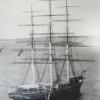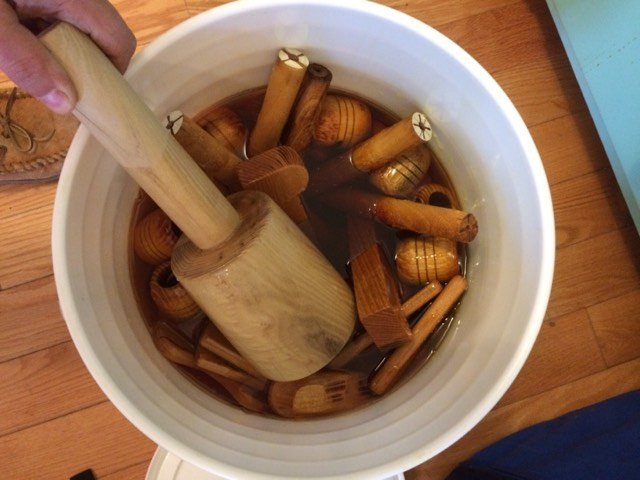-
Posts
980 -
Joined
-
Last visited
Content Type
Profiles
Forums
Gallery
Events
Posts posted by Sailor1234567890
-
-
Rob,
Are you saying that GR's courses would not have been set on the run down the coast? At 120 foot they are massive of course. I wonder what they would have weighed? How deep were they? Handling sails of that size would have been one heck of a lot of work for the crew. How big was the crew? 150 or more? She'd certainly be a sight to see. Anybody know of a rich crazy billionaire who might be interested in footing the bill?

-
Those were my thoughts as well. No stuns'ls... Too bad. Looking forward to seeing how she turns out though. Were there any other 4 masted extreme clippers built? I don't think so.
-
Any mate worth his salt wouldn't bother adjusting the lanyards anyway, that would put the deadeyes out of line. Yes, he can fine tune the rig that way but normally, if any slack developed, the lashing holding the shroud to the upper deadeye was re-made so the deadeyes were always at the same level. It would of course require setting up the lanyards again but the point was to have the deadeyes all level so fine tuning using the lanyards wasn't really done. As Mr. Cleek said above, they were normally not very slack. It was a periodic maintenance thing to adjust them, not a piece of running rigging that was adjusted with any frequency. Love your progress, she's on beautiful ship. Probably my favourite American Clipper. Cutty Sark being my favourite.
-
-
I hate to hijack your thread but how do you transition between the square portion and the rounded portion on your turnings of the clock pieces? They look very well done. I have heard that part is very hard to do but I have yet to turn anything like that. It's on my list of things to do but I want a bit more practice. I'm turning black locust which is incredibly hard. Tools need sharpening all the time. Thanks for any advice and the gun carriage is looking great. Look forward to seeing it completed.
-
-
-
OH, I must have misinterpreted then. Yes, she is most certainly one heck of a beautiful ship. I'm more a fan of the smaller British clippers, Cutty Sark in particular but for the most part both the earlier American and the British clippers that came 20 or so years later look the same. Sleek lines, graceful towering rigs and driven JUST to the breaking point and hopefully no further. Damage to rigging was all too common though as evidence that they were driven extremely hard. I'd put forth that they were driven harder than the iron and steel ocean carriers of the next generation. The iron and steel carriers could take more punishment but they weren't pushed quite as hard as the graceful clippers were. Almost, but not quite. Keep at it Ed, we all love your work. Sorry for the thread drift.
Cheers,
Daniel -
Rob, I completely agree with everything except one statement. I don't think they were the ultimate in strength to withstand the punishing their masters gave them. I think that palm goes to the iron and steel ocean carriers of the next generation. Pamir, Padua, Garthsnaid etc. Otherwise, your statements are eminently correct in my mind. I say this with a very strong preference for clippers over the later ocean carriers. Clippers were the ultimate sailing ship design in my mind. Beauty, speed, grace. They had it all. Now we have box like super tankers and container ships that can carry infinitely more cargo with a fraction the crew size but where's the fun in that?
Keep building Ed, your work is outstanding and I love to watch the progress, dreaming that one day someone might actually build one of these and show the world what it was like at sea in them.
-
-
-
-
The P shaped block and the other larger block are my topmast fids. A lanyard hole is required yet but it is much more rectangular than square. Parral beads, parral dividers, belaying pins, my newly turned carving mallet and a centreboard cleat at the bottom of the image are the other bits you see there. It's all Black Locust, my favourite wood. Sorry, it's 1:1 scale.
- Erebus and Terror, Piet, John Allen and 1 other
-
 4
4
-
-
-
WOW. Looking forward to seeing more of this project.
- Canute, Barbara Lange and mtaylor
-
 3
3
-
Having narrowed down the conversation to French and English, we've neglected the Spanish ships. Montanes I understand had the beauty and sailing qualities of the French ships but the strength and longevity of the English. Anybody know about the Spanish 74s and are willing to weigh in on them?
-
Brass plated pedestals? I built a 1:96 Revell CS in probably the late 80s/early 90s. It certainly didn't have brass plated pedestals. Looks like that's a much nicer kit than the later production runs. I purchased another one on Ebay, maybe 8-10 years ago. It's partially finished, ready for rigging at this point. Again, no brass plated pedestals.
-
I have a few as well. I have a french one about iron sailing ships between 1880 and 1930. I purchased it in Toulon a couple of years ago on the pretext that it would help me study for my french exams. Ha! That didn't work. It's still an interesting read. Sort of a Boudriot of French iron ships. The four posters and France with 5 certainly were a different beast for hauling volume but they could surely stand up to a blow. I seem to recall hearing somewhere that their lower tops'l sheets were not led to the deck but shackled to the course yard below as they were never furled at sea no matter what the conditions. Not sure of the veracity of that but it struck me as odd and as a testament to how strongly those ships were built. I'd love to have the opportunity to sail one (Kruzenshtern is the only one still sailing I think) but my real love is the little British tea clipper Cutty Sark. Sailing her would be a miracle dream come true for me. I'd replicate her given unlimited resources just so I can see what she's like running her easting down in the southern ocean.
-
I think Great Republic is a bit of an outlier, even amongst the larger ones, she's significantly larger. There's simply no comparison. How would the ones you've depicted compare with the iron four posters of the next generation size wise? Pommern, Padua, Lawhill, or the five master France? A bit outside the clipper ship area of expertise I guess but a valid question none the less.
- Omega1234, paulsutcliffe and mtaylor
-
 3
3
-
Glad to see you back. Any updates for us? How's Bellona doing?
- Old Collingwood and Canute
-
 2
2
-
-
Some would call playing with wires and stuff fumbling around but somehow a telephone was invented from that fumbling around. Call it what you like, we're calling it testing.

- Tigersteve, EdT, Calhoun Zabel and 1 other
-
 4
4
-
Greg, I think the answer to your question lies in where Ed went with his reply. The tops in these ships wasn't used like it was in warships. As Ed mentioned, they sent marines up to fire down on the enemy. This isn't a working platform in a Clipper ship. There wasn't a whole lot of work to do up there. It was just climbed up to get to the next level. Most of the work was done on the yards themselves so not much need to spend much time in the tops so... no railing. That's how I see it anyway.




HMS Bellona 1760 by SJSoane - Scale 1:64 - English 74-gun - as designed
in - Build logs for subjects built 1751 - 1800
Posted
Wait..... You don't wear a tie and waistcoat in your shop? Am I the only one who does?